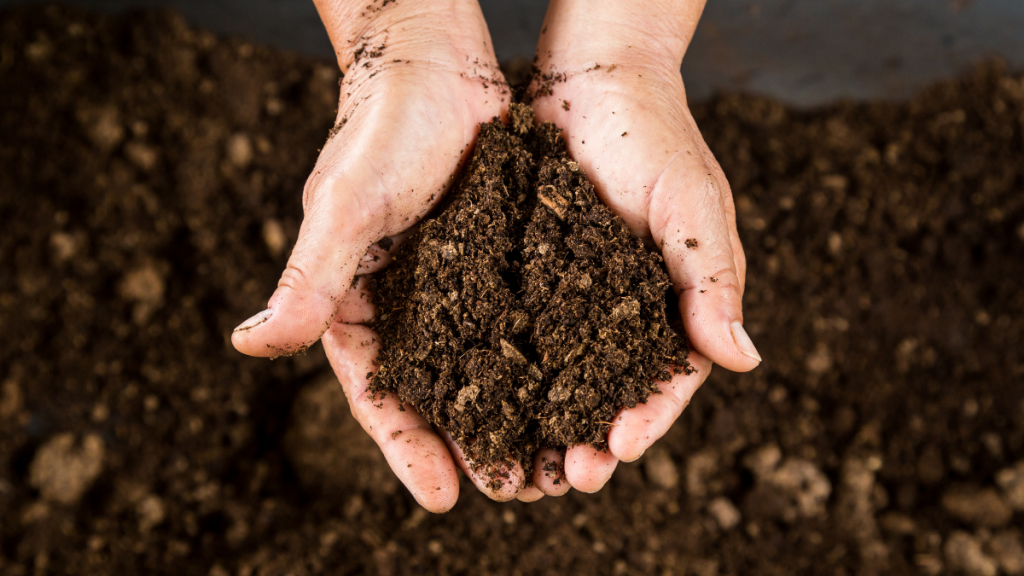Soils can look like they are a homogeneous material. But in reality, soil contains solid particles of different sizes and different types. Some of the particles are minerals, and others are organic matter. There are spaces between the particles called pores. These pores may be filled with air or water.

Minerals in soil and how they are weathered
The mineral particles in soil form as rocks and minerals break into smaller pieces, or change into other minerals due to “weathering.” Geologic processes such as flowing water and ice, growth of plant roots, heating and cooling of rocks, and rocks bumping into one another can break the rocks into smaller pieces. This is physical weathering: only the size of the particle has changed. The smaller particles are the same kind of rock or mineral as the larger particles from which they came.
Chemical and biological weathering, in contrast, changes rocks or minerals into other types of rock or even minerals through chemical or biological reactions, often with water that contains dissolved materials. The particles also may be smaller, but they are no longer like the rock or mineral from which they came.
Think about it this way: you have a cracker and break it in half. Each piece is still a cracker, just smaller. If you break it again, each piece is still a cracker. You might even be able to put it back together. This represents physical weathering.

Now put the cracker in your mouth and start chewing. Your teeth break the cracker into smaller and smaller pieces, but the saliva in your mouth mixes with the cracker as you chew. This starts the digestion process, and afterward the pieces of the cracker are no longer a cracker. You could not take the pieces out of your mouth and put them back together to form the cracker. This represents chemical weathering in which the rock or mineral is changed into another kind of rock or mineral.
Just like your saliva, microbes that live in soil can also break down mineral materials. They produce a “goo” that works to free up minerals – changing the composition of the soil. This is a biological change in the rock material. The same happens when moss and lichen cover rocks, starting to decompose them into other particles.
Many people have used vinegar and baking soda to make a volcano. This is an example of chemical weathering. Baking soda is a mineral and vinegar is a weak acid. When they are mixed together, a chemical change occurs, water and carbon dioxide are released, and the solid that remains is no longer baking soda.

Organic matter
Soil is home to the largest biodiversity on earth. Soil microbes (bacteria, fungi, and others) do lots of work to break down the plant and animal material left in soil. Earthworms, ants and other insects join in this effort to recycle dead materials into useful organic matter. If these organisms didn’t break down dead plant matter and other items, that refuse would just build up! This organic matter is like a sponge that helps retain water and nutrients in the soil.
This nutrient-rich substance can also be called humus (not hummus, which is ground chickpeas). It’s called “organic” matter because the most common element in the dead materials is carbon – and thus “organic” by nature. The finished product of your compost pile is also rich in organic matter. We want to keep as much carbon in the soil – in the form of organic matter – as possible. There are many things you can do at home to help this.

Soil particle size
Soil scientists separate the solid particles of soil based on their size. Particles between 2 and 0.05 millimeters are sands. Particles between 0.05 and 0.002 millimeter are silts. Particles smaller than 0.002 millimeter in size are clays.
The mixture of sand, silt, and clay particles determines soil texture. This is important to your gardens, and to farmers growing our food. To determine your soil texture, read this blog. In healthy soils, these particles and organic matter are held together into soil aggregates.
So, soils are composed of mineral and organic solids, water, and air. Plants, animals, and microorganisms living in the soil affect the soil properties we observe, especially the amount of organic matter and the soil structure.
Answered by Eric Brevik, Southern Illinois University
To receive notices about future blogs, be sure to subscribe to Soils Matter by clicking on the Follow button on the upper right! Explore more on our webpage About Soils. There you will find more information about Soil Basics, Community Gardens, Green Infrastructure, Green Roofs, Soil Contaminants, materials for Teachers and more.

The last word of this blog should be STRUCTURE … something I think I learned in the first lecture of my first soil science class.
We apologize for this error; we have fixed this. Thank you for pointing it out. SVF
Very detailed article on what soil is made of!